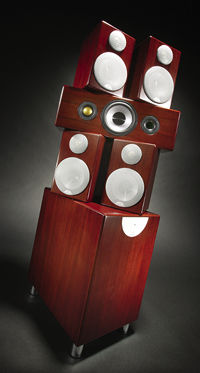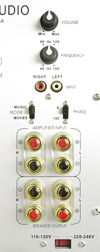Monitor Radius Speaker System
It must be something of a conundrum for speaker designers: Today's buyers are demanding more and more from smaller and smaller speakers. The designers' incredible shrinking speakers work their mojo with ever-more-innovative cabinet designs, and their high-tech drivers push the performance envelope. At least that's what they tell me. No doubt some of their more-extreme claims are jive techno babble, but that's OK—the sonic truth will inevitably be laid bare when the pedal hits the metal on the Fast and the Furious DVD. The pint-size speakers better deliver the goods. . .or else.
 Monitor Audio initially built their reputation with seriously potent minimonitors, then moved on to produce sleek towers with great success. Now they've introduced their smallest speakers ever: the 7.5-inch-tall Radius 90 satellite ($400/pair), the only slightly larger Radius 180 center speaker ($229), and their delightfully compact running mate, the Radius 360 subwoofer ($550). Gawd, they're itsy-bitsy things; could they possibly sound any good?
Monitor Audio initially built their reputation with seriously potent minimonitors, then moved on to produce sleek towers with great success. Now they've introduced their smallest speakers ever: the 7.5-inch-tall Radius 90 satellite ($400/pair), the only slightly larger Radius 180 center speaker ($229), and their delightfully compact running mate, the Radius 360 subwoofer ($550). Gawd, they're itsy-bitsy things; could they possibly sound any good?
One thing's for sure: These little speakers have big aspirations. The Radius 90 and 180 employ a single 4-inch metal matrix polymer woofer mated with a 1-inch ceramic-coated aluminum/magnesium dome tweeter. Instead of affixing the woofer to the cabinet with the usual four or six bolts, Monitor uses just one bolt. It enters through the rear panel and threads into the driver's backside. The single-bolt theory ensures that the periphery of the speaker's frame is evenly clamped in place. The tweeter is attached the same way; these bolts are precisely tightened with the appropriate amount of torque to provide structural bracing for the cabinet. It's all very clever, and these Radius speakers are the very first Monitor speakers to utilize this design feature, but it will likely be incorporated on future models. The Radius crossovers are chock-full of quality components: Metallized polypropylene capacitors and high-grade air-core and laminated iron-core inductors all serve in the effort to lower distortion and produce cleaner sound.
The Radius 180 can be positioned vertically or horizontally; you can use it as a center speaker or as a main, surround, or rear speaker. Since it's only 3.75 inches deep, it'll look neat hung on a wall next to a plasma or LCD screen. Monitor includes an adjustable, low-profile wall bracket and a packet of hardware with each speaker, so you won't have to shell out any extra dough to mount your Radiuses.
Monitor's speakers are known for their scrumptious real-wood veneers, so I wasn't exactly surprised by the selection of yummy finishes: rose mahogany, beechwood, satin video silver, gloss black, or gloss white. You also get two sets of perforated, color-coordinated metal grilles to better match your décor or taste. The cabinets' radiussed corners (get it?) add a touch of luxury, as do the all-metal, gold-plated cable connectors.
The sassy Radius 90 and 180 are decidedly bass-challenged on their own; they start rolling off at a high-ish 150 hertz. Luckily enough, they're matched up with a doozie of a subwoofer, the Radius 360. It's one of the smallest subs I've seen—just 8.75 inches wide, 14.5 high, and 12.5 deep. Its downward-firing, 8-inch, treated-paper cone driver is partnered with a 100-watt amp. The Radius 360 is an acoustic-suspension (sealed) design, so you'll never hear any chuffing and wheezing port noises from this little critter.
On the sub's milled-aluminum rear plate, you'll find a variable crossover-frequency control that runs from 40 to 180 Hz and a music/movie mode selector that offers a choice between extended and midbass-boosted response to bump up your DVD sound. Connectivity options include speaker-level inputs and high-pass-filtered speaker-level outputs; the latter might be useful with older stereo or Pro Logic receivers, but I stuck with the line-level RCA inputs. Unfortunately, the Radius 360 doesn't offer a bypassed/direct input, so your receiver's already-filtered sub output winds up traversing the Radius 360's built-in crossover, resulting in double-filtered low frequencies that will only make it more difficult to coax the sub into blending with the satellites. More gripes: The sub's annoyingly bright blue power-on LED was always threatening to burn my retinas during latenight sessions. I eventually got around to taping a piece of paper over the offending LED, but I wish Monitor would've moved the thing over to the rear panel. The sub sits on four machined-metal feet, which look cool; however, on my uneven wood floor, the sub rocked on three of the four feet until I stuck two nickels under one foot. If you ask me, Monitor should have made these things adjustable. The entire system was designed in the UK, but it's made with jewel-like precision in Taiwan.
For consistency's sake, I started the Radius auditions with my standard review rig: a Sunfire Theater Grand III pre/pro feeding my Ayre V6x power amp. It sounded nice enough, but I also wanted to hear what the speakers sounded like with lower-priced gear. I hooked up a wonderful $450 receiver, Harman/Kardon's brand new AVR 130, and Pioneer's $130 DV-343 DVD player. You could essentially duplicate this whole package for two grand and still have enough coin left over to pick up a few DVDs. It's a serious bang-for-the-buck system.
Perfecting the Radius setup in my home theater consumed the better part of an afternoon. You know the drill—futzing around with speaker and sub placement, diddling the crossover setting, and listening over and over to a bunch of reference CDs and DVDs. On the first go-rounds, the sats sounded awfully shrill, and the sub was bloated and lumpy. I'd ease the sub's level down, and the bass would become anemic; then I'd nudge the sub's level up a tick or change the crossover point or move the Radius 360 to a different location in the room. It sometimes felt like the audiophile equivalent of Goldilocks and the Three Bears—too much bass or too little, but I wanted it just right. Once I found the one magic spot where the sub/sat bass balance jelled, the acoustic-suspension subwoofer's taut definition handily trumped most ported baby subs, and the nimble Radius 360 easily kept pace with the sats.
 For me, the big question with teensy speakers is, can they pass my "lights off" test? Sitting in the dark watching a DVD, do I find the speakers' size-imposed limitations to be a distraction? Jim Carrey's holy romp Bruce Almighty loomed large, but it's hardly a trial of the Radius' moxie, so I cranked up a tightly wound heist DVD, The Italian Job, and the sub's nimble low-end prowess definitely throbbed and pulsed in all of the right places. Those maxed-out Mini Cooper chase scenes raised my blood pressure, dialogue was clear, and the Radiuses mustered enough soulful sound to keep me happy. So far, so good. The Radius' stature never crossed my mind. Next I cued up Governor Aaarnold's latest, Terminator 3: Rise of the Machines, and pummeled the system. Whew, even the nuclear blast that follows the opening credits didn't melt any voice coils. The lights-out audition went a lot better than I expected, and I didn't break anything!
For me, the big question with teensy speakers is, can they pass my "lights off" test? Sitting in the dark watching a DVD, do I find the speakers' size-imposed limitations to be a distraction? Jim Carrey's holy romp Bruce Almighty loomed large, but it's hardly a trial of the Radius' moxie, so I cranked up a tightly wound heist DVD, The Italian Job, and the sub's nimble low-end prowess definitely throbbed and pulsed in all of the right places. Those maxed-out Mini Cooper chase scenes raised my blood pressure, dialogue was clear, and the Radiuses mustered enough soulful sound to keep me happy. So far, so good. The Radius' stature never crossed my mind. Next I cued up Governor Aaarnold's latest, Terminator 3: Rise of the Machines, and pummeled the system. Whew, even the nuclear blast that follows the opening credits didn't melt any voice coils. The lights-out audition went a lot better than I expected, and I didn't break anything!
The Radius sextet also shined on the acoustic-oriented riffage on the Led Zeppelin concert DVD. Jimmy Page's guitar, in particular, was absolutely flawless; the instrument's body and tone were vividly real—no apologies needed vis-à-vis the speakers' stature. On the Jim Hall & Basses CD, Mr. Hall's fluid guitar flash stays mostly in the left channel, accompanied on each tune by one of five bassists in the right channel. On "Don't Explain," Charlie Haden's stand-up bass was fully formed, his exquisite fingerings, slides, and plucks all seemingly coming from the teeny Radius 90 over on the right. This is a neat trick because most of Haden's bass foundation was provided by the subwoofer, way over to the left of the left speaker, a good 9 feet away from the right Radius 90. With lesser sub/sat systems, I always hear the bass veering over to the left when the bassist plays the lowest notes, but the Radius system never faltered.
Damn, I wish I'd held onto the micro sub/sat system that caught my fancy last year, the Totem Acoustic Dreamcatcher (May 2003). The Totem and Monitor systems are both excellent; as I recall, the Totem's larger sats were even more musically inclined, with a richer, warmer midrange balance, but the Radius system's stronger suit is home theater hijinx. I'll credit that score to the Radius 360 sub; it kicks harder. Its sheer articulation and gung-ho dynamics should make for a satisfying long-term relationship.
I'm not about to tell you that the Radius ensemble is a threat to any of the full-size (and many times more expensive) badaboom, bass-proficient speaker packages. That said, the Monitor Audio Radius system's awesome power-to-weight ratio will shine in a cozy bedroom or living-room home theater.

Highlights
• Gawd, they're tiny!
• Spunky mini sub
• Innovative design details
Radius 90 Speaker $400/pair
Radius 180 Center-Channel Speaker $229
Radius 360 Subwoofer $550




























































